Tecmo Bowl Play Books
The playbook for each team is vital to their success. Talent on the roster plays, but the playbook is the ultimate factor in how effective the offense can be. Another key aspect concerning the playbook is how well a team is suited to defend it. That's where the match-up aspect ultimately takes hold.
Colts Playbook
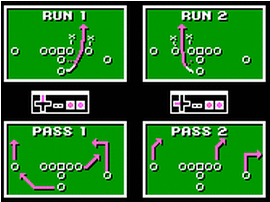
This is the best passing playbook in the game. The routes are spread far enough apart that with patience, even Jack Trudeau can hit the underneath targets. The playbook compensates for his poor throwing ability. Eric Dickerson's speed forces the defense to call lots of run plays, allowing the passing game to thrive.
Defending it: The 2 base calls are Run 1 & Pass 2. Calling Run 1 gives you CPU controlled coverage from the top DB when Indy goes with Pass 2. Calling pass 2 will create CPU controlled coverage from the top DB when Indy's offense goes with Pass 1. These are key calls as the CPU will cover the top WR in both scenarios, which gives Trudeau smaller windows to throw into. See illustration below for a full explanation.
Defending it: The 2 base calls are Run 1 & Pass 2. Calling Run 1 gives you CPU controlled coverage from the top DB when Indy goes with Pass 2. Calling pass 2 will create CPU controlled coverage from the top DB when Indy's offense goes with Pass 1. These are key calls as the CPU will cover the top WR in both scenarios, which gives Trudeau smaller windows to throw into. See illustration below for a full explanation.
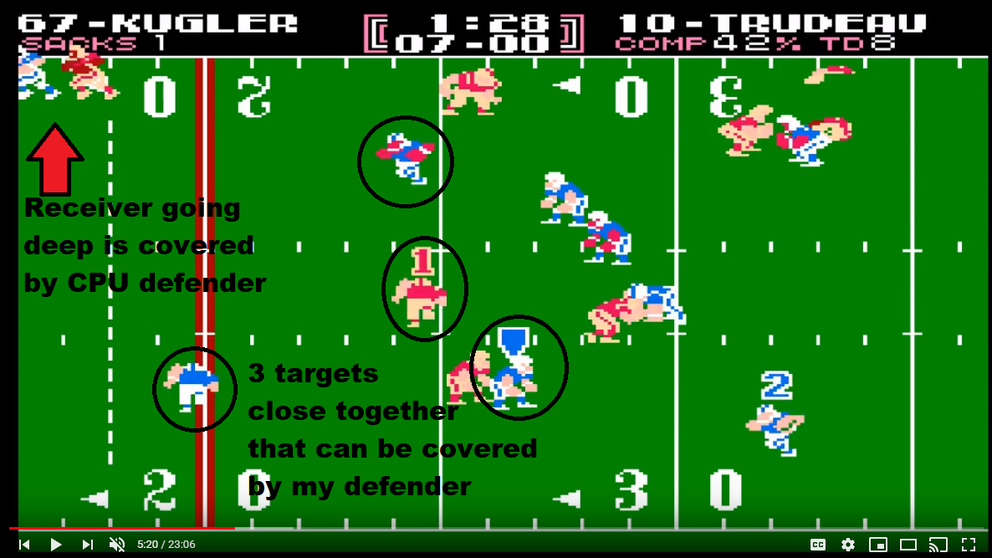
This illustrates why the "Base calls" on defense are critical, as pass coverage help from a CPU defender negates big plays.
Indy offense called Pass 1, & the defense called Pass 2. As a result the CPU controlled defender is covering the WR going deep(Red Arrow). This allows my defender (#1) to cover all 3 underneath routes (circled). I may not get an interception in this scenario, but it limits big plays by the offense. The more attempts you force into tight windows, the more chances for an interception.
There is a caveat. To get this pass coverage help, you may not control the topside DB, which is Ronnie Lott. You have to learn patience on defense & trust the scheme.
Indy offense called Pass 1, & the defense called Pass 2. As a result the CPU controlled defender is covering the WR going deep(Red Arrow). This allows my defender (#1) to cover all 3 underneath routes (circled). I may not get an interception in this scenario, but it limits big plays by the offense. The more attempts you force into tight windows, the more chances for an interception.
There is a caveat. To get this pass coverage help, you may not control the topside DB, which is Ronnie Lott. You have to learn patience on defense & trust the scheme.
49ers Playbook
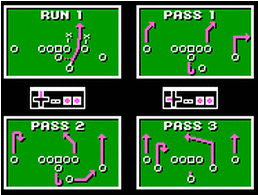
Good routes with targets spread apart. Craig is a great option as a check down receiver with pass 2. Montana's throwing ability means you can thread the needle & complete throws other QBs can't. Pass 3 spread the field & allows for quick strikes to the top to bottom.
Defend it: A steady dose of Pass 1 puts the CPU controlled bottom outside LB in coverage on Jerry Rice, when San Fran chooses Pass 2 or 3. That's key as it takes away the deep threat & forces Joe Montana into throwing to tighter windows where mistakes can happen. The key vs San Fran is to stay in that Pass 1 call often & force them to slowly drive downfield. The more passes thrown, the more chances a mistake will happen.
Defend it: A steady dose of Pass 1 puts the CPU controlled bottom outside LB in coverage on Jerry Rice, when San Fran chooses Pass 2 or 3. That's key as it takes away the deep threat & forces Joe Montana into throwing to tighter windows where mistakes can happen. The key vs San Fran is to stay in that Pass 1 call often & force them to slowly drive downfield. The more passes thrown, the more chances a mistake will happen.
Browns Playbook
Both pass plays are effective with routes spread out. Pass 1 offers a safe dump off to Kevin Mack. Bernie Kosar is the best 2nd tier QB, capable of making throw into tight windows. Pass 2 features the safe & effective tight end out-route to the sideline. Lure the defender elsewhere then click to Ozzie Newsome & make the safe throw.
Defend it: Kevin Mack is powerful but lacks speed. Load up on pass calls, & dare Cleveland to have Mack beat you. When calling either pass play, you really don't get very beneficial CPU pass coverage help on the other pass play. Unfortunately its kind of a guessing game vs Cleveland, unlike facing a lot of other teams.
Defend it: Kevin Mack is powerful but lacks speed. Load up on pass calls, & dare Cleveland to have Mack beat you. When calling either pass play, you really don't get very beneficial CPU pass coverage help on the other pass play. Unfortunately its kind of a guessing game vs Cleveland, unlike facing a lot of other teams.
Giants Playbook
Pass 1 is unspectacular as the routes all curl & end up close to each other, especially w/ Simms' mediocre arm. Pass 2 is the go-to pass play for New York. Like Cleveland the key is to let the routes develop, lure the defender elsewhere then click down to Mark Bavaro who sits by the sideline.
Defend it: The base calls are Run 2 & a top DB, or Pass 2, which gives you CPU pass coverage help on the bottom receiver when the offense goes to Pass 1. The Pass 2 defense, creates a small window for Simms when New York goes to Pass 1. Joe Morris is pretty average, so like Cleveland it's a good idea to dare them to beat you on the ground, while you sit on Pass 2.
Defend it: The base calls are Run 2 & a top DB, or Pass 2, which gives you CPU pass coverage help on the bottom receiver when the offense goes to Pass 1. The Pass 2 defense, creates a small window for Simms when New York goes to Pass 1. Joe Morris is pretty average, so like Cleveland it's a good idea to dare them to beat you on the ground, while you sit on Pass 2.
Vikings Playbook
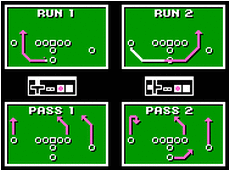
The pulling guard on Run 1 gives the top side defensive back some issues as it blocked well. Pass 2 is pretty solid with Darrin Nelson coming out of the backfield.
Redskins playbook
Pretty much as vanilla of a playbook as it gets in Tecmo Bowl. Nuff said.
Raiders Playbook
Use the Raiders speed for this playbook to be effective. Obviously Bo is quick, and Allen too. There's speed in the passing game with Christensen and Brown, despite Schroeder's less than strong arm. The pass routes are spread out nicely here, and you can do real damage when the running game is working well.
Cowboys Playbook
Nothing too flashy here, other than the shot gun play which is pretty nice...especially with Herschel Walker going out for a pass, which can really be deadly. Pass 1 is great when you catch the defense in a run call.
Dolphins Playbook
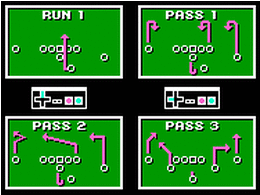
Other than the shotgun play, pass 1 & 2 are pretty vanilla. The good news is that Marino's cannon of an arm makes those passes hard to defend, even with some of the fastest defenders. Typically we just quickly rifle passes out after the snap for 6-7 yard gains.
Seahawks Playbook
Seattle's playbook overall isn't bad. By not having elite players, it does hinder it a bit. No facet of the offense is very explosive. Pass 1 is pretty good as you have 3 receivers all spaced out nicely.
Broncos Playbook
Denver has a pretty dangerous run game and when that's clicking, it really opens the passing game up. Denver has a set of slow receivers, so that somewhat offsets Elway's strong arm.
Chicago Bears playbook:
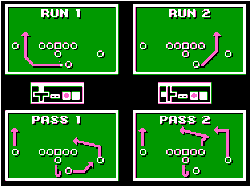
Chicago's playbook is a bit conservative in the passing game. The run plays are adequate, especially with Walter Payton carrying the ball.
The pass plays typically don't net you large chunks of yardage, especially if the deep WR covered, but the dump off pass to Payton on pass 1 can be deadly.
Defend it: Go with a lot of Run 1 & the top DE, & then occasionally switch to a pass call & a bottom defender to get the deep WR covered by the computer to slow them down in the air.
The pass plays typically don't net you large chunks of yardage, especially if the deep WR covered, but the dump off pass to Payton on pass 1 can be deadly.
Defend it: Go with a lot of Run 1 & the top DE, & then occasionally switch to a pass call & a bottom defender to get the deep WR covered by the computer to slow them down in the air.
